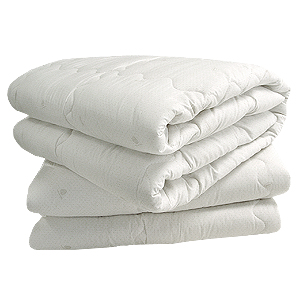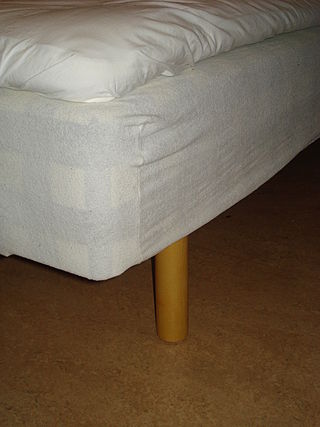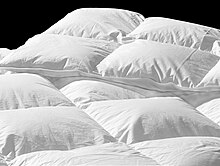
A futon is a traditional Japanese style of bedding.

A pillow is a support of the body at rest for comfort, therapy, or decoration. Pillows are used in different variations by many species, including humans. Some types of pillows include throw pillows, body pillows, decorative pillows, and many more. Pillows that aid sleeping are a form of bedding that supports the head and neck. Other types of pillows are designed to support the body when lying down or sitting. There are also pillows that consider human body shape for increased comfort during sleep. Decorative pillows used on beds, couches or chairs are sometimes referred to as cushions.

Bedding, also called bedclothes or bed linen, is the materials laid above the mattress of a bed for hygiene, warmth, protection of the mattress, and decorative effect. Bedding is the removable and washable portion of a human sleeping environment. Multiple sets of bedding for each bed are often washed in rotation and/or changed seasonally to improve sleep comfort at varying room temperatures. Most standardized measurements for bedding are rectangular, but there are also some square-shaped sizes, which allows the user to put on bedding without having to consider its lengthwise orientation.

A bed is an item of furniture that is used as a place to sleep, rest, and relax.
A silk comforter (絲綿被) is a bed covering, most often used as a duvet, and also commonly referred to as a silk duvet, silk quilt, or silk blanket. Originally used and made in China, since the late 20th century, silk comforters have become more common in Western market areas. Their increasing popularity stems from a combination of factors, including their thermal properties, their light weight, and their natural hypoallergenic properties. The opening of the Chinese market to the world since the 1990s has also played a significant role in the spread of silk comforters, as China is both the world's biggest silk producer and silk comforter manufacturer.

The down of birds is a layer of fine feathers found under the tougher exterior feathers. Very young birds are clad only in down. Powder down is a specialized type of down found only in a few groups of birds. Down is a fine thermal insulator and padding, used in goods such as jackets, bedding, pillows and sleeping bags. The discovery of feathers trapped in ancient amber suggests that some species of non-avian dinosaur likely possessed down-like feathers.

A bed sheet is a rectangular piece of cloth used either singly or in a pair as bedding, which is larger in length and width than a mattress, and which is placed immediately above a mattress or bed, but below blankets and other bedding. A bottom sheet is laid above the mattress, and may be either a flat sheet or a fitted sheet. A top sheet, in the many countries where they are used, is a flat sheet, which is placed above a bottom sheet and below other bedding.

A comforter, also known as a doona in Australian English, or a continental quilt or duvet in British English, is a type of bedding made of two lengths of fabric or covering sewn together and filled with insulative materials for warmth, traditionally down or feathers, wool or cotton batting, silk, or polyester and other down alternative fibers. Like quilts, comforters are generally laid over a top bed sheet and used to cover the body during sleep. Duvets are another form of quilt, traditionally filled with feathers, though since the late 20th century often made of synthetic fibres or down alternatives.
Linens are fabric household goods intended for daily use, such as bedding, tablecloths, and towels. "Linens" may also refer to church linens, meaning the altar cloths used in church.

Ticking is a type of cloth, traditionally a tightly-woven cotton or linen textile. It is traditionally used to cover tick mattresses and bed pillows. The tight weave makes it more durable and hinders the stuffing from poking through the fabric. To make it even tighter, ticking could be waxed, soaped, or starched. Tick materials designed to hold foam may be knit, or more porous. In English-speaking countries ticking commonly has a striped design, in muted colors such as brown, grey or blue, and occasionally red or yellow, against a plain, neutral background.
A law label is a legally required tag or label on new items describing the fabric and filling regulating the United States mattress, upholstery, and stuffed article industry. Typically these tags begin with a phrase such as This tag may not be removed under penalty of law except by the consumer. Some states require tags on used bedding as well.

Tontine is an Australian manufacturer of pillows and quilts. The company can trace its origins back to 1870 when the Galt family commenced manufacturing in Melbourne. From 1984–2001 it was owned by Pacific Dunlop. The Tontine group was part of Pacific Brands until early 2017. Tontine is now owned by John Cotton Group. Until 2007 the company's manufacturing base was at East Brunswick, Victoria. Tontine Fibres is a division of United Bonded Fabrics a separate company manufacturing polyester insulation, air filtration, carpet underlays, geotextiles and a range of mattress and furniture comfort products and using the Tontine trademark under license.

A mattress protector is an item of removable bedding that sits on top of, or encases, a mattress to protect it. Some mattress protectors also provide protection to the person sleeping on the mattress from allergens and irritants such as dust mites, bed bugs, mold, and dead skin.
Fill power is a measure of the loft or "fluffiness" of a down product that is loosely related to the insulating value of the down. The higher the fill power, the more air a certain weight of the down can trap, and thus the more insulating ability the down will have. Fill power is commonly given as a specific volume, expressed in cubic inches per ounce. Common fill power values range from about 300 cubic inches per ounce (170 cm3/g) for feathers to around 900 in3/oz (520 cm3/g) for the highest quality goose down. The rare and relatively expensive down of certain wild waterfowl species such as the Muscovy duck or Common eider can have higher fill powers than goose down. Higher fill powers are associated with a larger percentage of down clusters and a larger average down cluster size.

Pacific Coast Feather Company is a Boca Raton, Florida-based manufacturer of basic bedding including pillows, comforters, sheets, and featherbeds.

A mattress pad, mattress topper, or underpad is designed to lie atop a mattress. Made from a variety of materials including wool, cotton, memory foam, feather and latex, its function is to provide an extra layer of comfort, especially when the existing mattress is worn or uncomfortable.

A bed base, sometimes called a foundation, is the part of a bed that supports the mattress. The bed base can itself be held in place and framed by the bedstead. In the United States, box-spring bed bases are very common. In Europe, sprung slats are much more common.
Arzaai or Razai is a bedding (quilt) very similar to, if not a type of, duvet or comforter, used in Afghanistan, Pakistan, India, Bangladesh and Nepal. Razais usually have a cotton, silk or velvet cover which is stuffed with cotton wool. They can provide a great deal of warmth even in the very cold weather that can occur in these regions, primarily due to the insulating effects of the large amount of air trapped in the cotton wool.

A tick mattress, bed tick or tick is a large bag made of strong, stiff, tightly-woven material (ticking). This is then filled to make a mattress, with material such as straw, chaff, horsehair, coarse wool or down feathers, and less commonly, leaves, grass, reeds, bracken, or seaweed. The whole stuffed mattress may also, more loosely, be called a tick. The tick mattress may then be sewn through to hold the filling in place, or the unsecured filling could be shaken and smoothed as the beds were aired each morning. A straw-filled bed tick is called a paillasse, palliasse, or pallet, and these terms may also be used for bed ticks with other fillings. A tick filled with flock is called a flockbed. A feather-filled tick is called a featherbed, and a down-filled one a downbed; these can also be used above the sleeper, as a duvet.
















